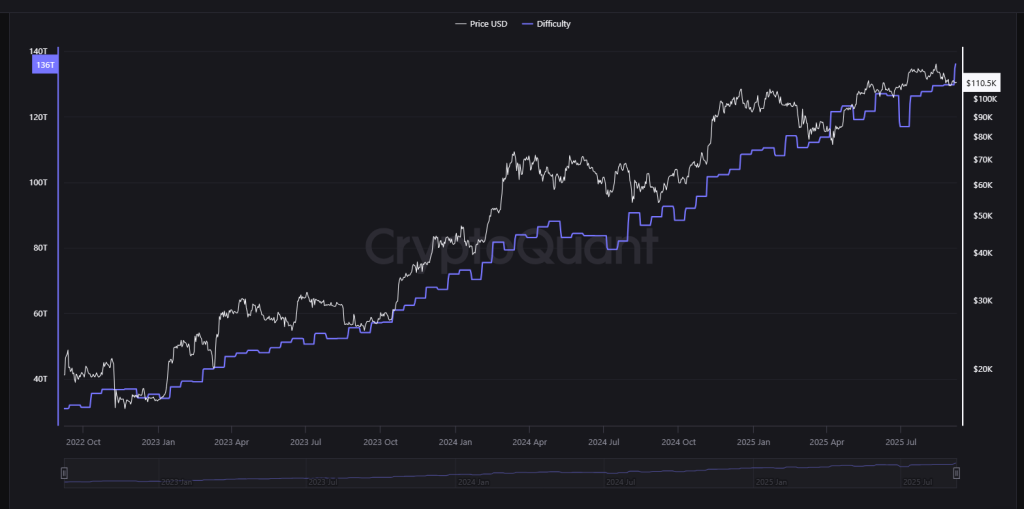New Peak: Bitcoin Mining Difficulty Soars To 135 Trillion


Bitcoin’s mining math hit a fresh high this week as the network’s difficulty climbed to a new all-time peak of 135 trillion. Miners now need more computing work than ever to win a block, while the overall hashpower available to the network has slipped from its summer peak.
Mining Difficulty Reaches New High
According to on-chain data, network hashrate fell to 967 billion hashes per second after topping 1 trillion hashes per second on August 4. That gap — rising difficulty paired with a lower hashrate — tightens margins for miners.
Reports have disclosed that higher difficulty makes mining more costly, and the pressure is felt most by smaller operations that run on narrow profit margins.
Big miners have room to scale. Smaller teams do not. Costs for electricity, machines and maintenance add up fast. The situation raises concern about concentration. As the cost to operate rises, larger pools and firms are better positioned to absorb the pain and keep hashing.

Solo Miners Still Score Big
Despite those headwinds, Three solo miners managed to land blocks in July and August, proving the system still hands out rewards to individuals now and then. Reports show the block subsidy is 3.125 BTC per block. On July three, a solo miner found block 903,883 and took home just under $350,000 in subsidy plus fees.
Another solo miner added block 907,283 on July 26, claiming over $373,000 when prices at the time were used to value the reward. On August 17, block 910,440 was mined by a solo operator, yielding roughly $373,000 in subsidy and fees.
Those payouts highlight two facts. First, solo success is rare but possible. Second, occasional large rewards do not erase the steady advantage of scale. Pools still smooth earnings for participants, and many miners use them to avoid long dry spells.
Seasonality And Market PatternsMeanwhile, September has a poor historical record for Bitcoin , with an average return of -3.77% across 12 years beginning in 2013, researchers say.
Bitcoin endured six straight losing Septembers from 2017 through 2022. The streak reversed in 2023, and 2024 closed out as the best September on record at +7.29%.
What This Means NowIn short, the network’s math is becoming tougher at the same time mining capacity dipped slightly. That creates tighter margins and fuels debate over centralization as scale matters more.
Yet the ecosystem still shows variety: solo miners can and do win blocks, and market history gives investors a mixed picture where seasonal trends matter but do not guarantee outcomes.
For now, miners and market watchers alike will be tracking difficulty, hashrate and price swings as the fall unfolds.
Featured image from Unsplash, chart from TradingView

Ethereum Mirrors Bitcoin Post ATH Movement, As Market Bears Target 20% Correction
Popular crypto analyst and key opinion leader Ted Pillows has outlined an insightful trend in the Et...

A Chainlink Pullback To $16 Could Set Up Parabolic Price Rally – Analyst
Chainlink (LINK) prices have dropped by 5.63% in the past seven days, amid a broader, volatile marke...

Bitcoin Holds Key Support Amid Gravestone Doji – $120,000 Hangs In Balance
In his latest daily technical outlook, Cryptowzrd highlighted that Bitcoin closed the day with a gra...

